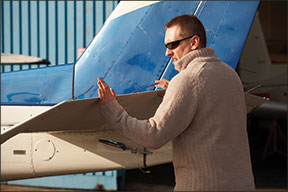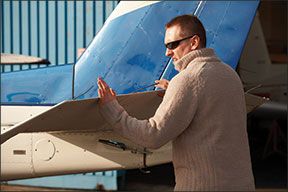When did you last experience an embarrassing moment on the takeoff roll? Have you ever had to taxi back to the ramp to deal with a problem discovered during the run-up? Any moments of tension or near-terror because you missed something during the pre-flight? Most pilots can recite at least one tale about discovering they missed something in the pre-flight inspection. The idea at its root is to never, ever start the engine without a thorough look-around to be sure all remains as it was when you last landed the airplane. In the case of the day’s first flight, you’re conducting an inspection to confirm the aircraft’s airworthiness, general condition, fuel status, etc.

288
From our first lesson, first day, first flight, instructors and texts drill into us the importance, the value, of a thorough pre-flight inspection before engine start. We hear it again when checking out on a plane new to us. Nonetheless, our pre-flight-inspection success rate suffers from all the usual human foibles. If we’re lucky in what we miss, we suffer little more than embarrassment. When not, accidents result, from merely embarrassing to fatal.
Top Ten Accident Contenders
While any miss during a pre-flight is a miss too many, the mostly embarrassing dominated the commonly confessed issues. Of course, what you don’t know can hurt, and we generally don’t know we’ve missed something until it manifests itself, too often with major safety implications. Thus, it’s no wonder so many organizations—from the FAA, NTSB, NASA’s Aviation Safety Reporting Service (ASRS) and many of the alphabet groups—continue to invest in efforts to reduce these most-preventable of accidents.
In a presentation on what it considers the top 10 accident causes, the FAA noted five areas in which incomplete pre-flight inspections could be reasonably inferred to contribute to the event, though perhaps not in a way that always makes it into the probable-cause finding. For example, at number 10 on the list (see the sidebar on the opposite page), the FAA lists encounters with wind shear or thunderstorms. We’d suggest old-fashioned “get-home-itis” is a contributing factor in these accidents, as well as indications pilots failed to obtain or understand weather information before takeoff, an integral element in full pre-flight preparation. Of course, the ASRS includes scores of pilot reports describing a problem because of a poor or incomplete walk-around.
One professional CFI, retired from instructing individual and two-pilot crews in everything from piston singles and single-pilot business jets to multiple-crew aircraft, stressed that the main problem repeatedly traces back to a lack of focus and distractions unrelated to the pilot’s flying job.
“But blowing it off as ‘expectable human error’ is unacceptable. Either your head’s in the task or it isn’t,” said Chuck Donham, a Wichita, Kan.-based ATP, CFI/I and contract pilot. “You perform the pre-flight, completely, or you’re flying an airplane in unknown condition. We’ve all done it, but the pilots paying attention do it only once. If they’re around to tell the tale, they lucked out.”
Many pilots seemed to consider the most-common misses so benign as to question the safety value of drubbing them. But many pilots were less lucky. And glossing over “benign” misses as expectable and unimportant misses the point. The goal is to miss nothing. Only then is there no question, no doubt, the aircraft is ready for what you’re about to ask it to do. To explore the difference, we offer two lists, the first presenting benign misses of relatively little threat; the second addresses those misses with significant safety implications every time.
Benign Blew-its
Consider the ease with which we miss, overlook or otherwise forget to check or act on problems in these five areas and how embarrassing they can be when you have an audience:
1. Wheel Chocks: The left-in-place wheel chock, often in blocking the nosewheel. The number of pilots who confessed to this staggered the writer; upward of 60 percent of pilots questioned during visits to several GA airports. The risk here is low—damage to the gear—and seldom occurs. Instead, we lose time shutting down, removing the problem chock and restarting the engine, to say nothing of the embarrassment of doing this on a crowded ramp and with passengers.
2. Rope-A-Do’h: The missed chock’s counterpart turned out to be failure to remove tiedown rope, or ropes. In this scenario, tail tiedowns beat out the other two; interestingly, tailwheel airplanes trailed tricycle-gear in this error. The biggest risk here could be a collapsed strut or spinning around one wing after applying power to taxi without recognizing the problem. Another risk is damaging the tail tiedown ring and surrounding structure if there’s enough slack to permit some momentum to build before the rope goes taut. In extreme cases, aircraft have pulled the tiedown anchor out of the ground and departed, trailing the evidence. Most of us suffer nothing more than a red face.
3. Cowl Latches: The unlatched cowl rates high on the embarrassment scale, right up there with chocks and ropes. But this “benign” miss can turn deadly after takeoff.
If you notice the flapping cover or hovering hatch during taxi or run-up, you’re right where you need to be—on the ground. In flight, unsecured cowl pieces can depart the aircraft; errant pieces of flying sheet metal or composite structure don’t mix well with the airframe—empennage, wing leading edges or windshields. Losing part of a twin’s cowl can make the aircraft a major challenge to control. Fatal outcomes have occurred.
4. Tire Tales: A tire failure straddles the fence between totally benign and potentially dangerous. And they can blow because the pilot missed checking their condition. Perhaps the most common failure of general aviation aircraft tires involves underinflation, allowing tire and tube to spin around the rim and separate the valve stem. Overinflated tires can burst under the impact of a hard landing or heat buildup during the takeoff roll.
Suffer any flat on takeoff or landing, and you’re fighting a runaway plane. That raises the risk of losing control, regardless of how it goes flat.
5. The Door Jam: Our primary CFIs drilled us on handling a door opening in flight. While some designs seem prone to the problem, in most cases the pop-open happens because of our failure to assure the door is closed, latched and locked.
This is another miss that should, by all the impact a popped door has on performance, be a double-decker nothing-burger. Yet accidents and fatalities associated with this problem occur, usually because the pilot loses focus on flying the plane while working to close it. The usual cure is landing to secure the door properly. Always remember Job One—fly the airplane.
Five Always-Dangerous Misses
With the benign pre-flight misses out of the way, let’s explore their not-so-benign cousins. These generally show up only after takeoff and always have a higher probability of contributing to an accident or, at least, an incident.
1. Fuel Starvation 1: Accident and incident reports are thick with instances of pilots exhausting fuel, and being surprised by the premature silence. The explanations are legion: “Looked in the tanks and thought they had plenty of fuel…” (The crash site showed no evidence of leaked fuel after the forced landing.) “I did the walk-around before ordering fuel and when I came back, they said they’d topped off the tanks.”
If you fail to check the tanks, there’s no way to know for sure. Only you can prevent fuel starvation.
2. Fuel Starvation 2: Sometimes the airplane gets all the fuel sought and the pilot confirms the top-off and still runs dry prematurely. A recurring cause is because the pilot failed to secure the filler caps, or failed to check the vents.
Accident reports include instances of the pilot inadvertently loosening one or both caps when using them as a handhold—to check that the caps are indeed on the tanks. Low-wing pilots have a slight advantage in spotting fuel siphoning out through the filler necks; good thing, because this failure hits high and low alike.
Use a ladder for the high-wings, and add a flashlight for inspecting both high- and low-wing airplanes.
3. Pitot Cover-ups: For the high-wing pilot, missing the waving “REMOVE BEFORE FLIGHT” banner is a little tougher than for the low-wing pilot. In neither instance should this miss lead to bent metal, injury or death. But it often does.
With the pressure side of your pitot/static system blocked, you may see the airspeed indicator rotate backward—if at all—thanks to the vacuum produced by air flowing over the static source. Panic and distraction raise the potential for damage.
One way to spot this problem on the ground—aside from finding it during the pre-flight—is to ensure the airspeed indicator is “alive” early in the takeoff ground roll. Regardless, power plus pitch equals performance: A specific engine power setting and pitch attitude produces the same airspeed and rate of climb or descent, every time. Use appropriate power and pitch settings and land safely.
4. Don’t Become A Dipstick: We always check the oil and add some when needed, but we don’t always replace the dipstick or cap. Small as it is, the dipstick tube can siphon off all the engine oil; same for the oil filler. Common risks include oil-obstructed windscreen and windows and engine fire.
5. Casual Pre-flights: Being too casual in our pre-flight inspections can turn into sundry stupid human tricks. No need to check oil—it was just changed last week, and the engine and its controls checked out well during the post-maintenance flight. So what’s the problem with skipping all but the major pre-flight items—fuel, air in tires, controls free—and omitting a look-see under the cowling?
Here’s one: Small birds can build nests in hours. An engine-compartment fire is a major emergency, and a likely one after taking off with a nest on the engine. What about that screwdriver you can’t find? It’s bouncing around in the tailcone, where you left it, waiting to become wedged in a control-cable pulley.
Meanwhile, spiders quickly can web over a pitot tube or static source, and wasps can mud over the fuel-tank vents in minutes.
Checkin’ with a Checklist
The best way to assure you cover all the manufacturer and additional items is that time-proven standard of aviation: the checklist.
While the many commercial versions may serve as a starting point, it’s likely that changes to the airplane brought in new items; use the commercial or factory list to develop an expanded to-check checklist. By building on the factory specifics for your plane, you can then include items added to it—items or upgrades not originally part of what the factory delivered.
For example, the standard checklist for a plane we once owned covered all the necessities the airplane sported in 1961. But that list didn’t include pre-flight checks of a stand-by vacuum system added later, or checking the alarm incorporated into a visual and audible gear-alert system, or a voltage-trip warning system, all of which was added later. They were, however, on the updated checklist for the plane’s lucky buyer.
Pre-flight Strategies
The people involved in my flight training and education pressed a near-dogmatic insistence on overall preparation, but without dictating one solution or another as superior. They insisted their students know and understand why certain things must be done and often provided graphic examples of the failure’s results. How the student fulfilled the need concerned them less than knowing he or she embraced a system, method or practice and used it regularly. With that in mind, the sidebar on page 23 lists five suggestions designed to make your pre-flight inspections as effective as possible..
No one enjoys taking off only to hear the voice in our head suddenly question whether something got checked and cleared. If that happens, land—safely, but quickly—and resolve your doubts for good.




